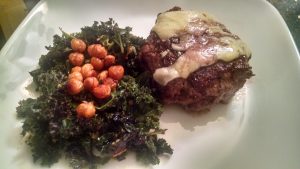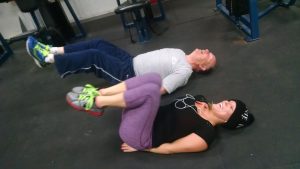I am/was honored to speak at the Delta Chi Region IV Regional Leadership Conference, held at Truman University in Kirksville, Missouri. Since we all have brains, not just these great, smart group of guys, here’s a summary for them, and all my readers:
Take care of your brain, live long and prosper!

The theme is what you can do through lifestyle (utilizing the pillars of nutrition, movement, recovery, life purpose and spirituality), to really not only amp up your brain power:

but maximize your long-term healthspan. I didn’t say age, I said healthspan, for that is the quality years we all have on this earth being relatively disease-free:

To start off, we have to measure where you all are coming from. You are males first and foremost. I must admit, most health information is geared to the female gender, but today, you all are front and center. Your health is just as important and simple lifestyle changes can definitely help you too!
You also are predominantly from the millennial generation, which offers it’s own set of challenges. You are highly educated, have an average of 33k in debt, 40% of you are unemployed and (per Psychology Today) are the most stressed, depressed and anxious population in the U.S. today compared to prior generations of your age group:

That being said, there is some low-hanging lifestyle fruit you can utilize to combat some of the negatives of life that are thrown your way, utilizing the pillars of health as your armor!
I have written a number of blogs on each aspect of lifestyle, so please feel free to use this resource also @ Drtobler.com.
Throughout this presentation I will be referring to telomeres as being both a marker for health AND the cause of damage at the genetic level. Telomeres are the non-coding ends of each of our chromosomes (for everyone of our 37.2 billion human cells there are 46 chromosomes):

One way of thinking of them is as the anklets on the end of a shoelace:
 If you shorten those anklets (telomeres) they are subject to fraying, you lose the integrity (health) of the your shoelaces (chromosomes). Please refer to The Telomere Effect by Nobel Prize Winner Dr. Elizabeth Blackburn and Dr. Elissa Epel for a more in depth discussion of how lifestyle choices (i.e. nutrition, exercise, negative self-talk, stress response, sleep and life purpose) directly affect the health of your telomeres. Dr. Epel was a guest on our “Healthy U.” radio show recently and painted the shoelace word picture for us.
If you shorten those anklets (telomeres) they are subject to fraying, you lose the integrity (health) of the your shoelaces (chromosomes). Please refer to The Telomere Effect by Nobel Prize Winner Dr. Elizabeth Blackburn and Dr. Elissa Epel for a more in depth discussion of how lifestyle choices (i.e. nutrition, exercise, negative self-talk, stress response, sleep and life purpose) directly affect the health of your telomeres. Dr. Epel was a guest on our “Healthy U.” radio show recently and painted the shoelace word picture for us.
Epigenetics refers to the effects that their environments have on gene activity, and today I’m talking about the power YOU have to turn on or off the genetic hand of cards you were dealt in life:

For science strongly supports the fact that it is not nature vs. nurture, but actually nature equaling nurture, meaning you have the power (at least 50% in most cases) to make lifestyle choices that influence your genetic hand of cards, be they good or bad.
So let’s set up the pillars of a healthy lifestyle:
I. Nutrition– Use Your H.E.A.D. for Healthy, Enjoyable, Achievable Dining.
A. Healthy–
1. Inflammatory Fighters-Choose foods that fight inflammation, remembering that the beginning of all chronic disease is inflammation. Remember Omega 6 fatty acids (corn, soybean) are pro-inflammatory while Omega 3s (flaxseed, walnuts, cold-water fish) quench that inflammation. Remembering you are what you eat, eats!! Your brain is 60% fat and of that 60%- the Omega 3s, specifically DHA represents about 15-20%. The best choice of inflammatory food-fighters? Eat cold-water wild-caught fish sources a couple times per week (salmon, sardines, tuna):

However, if you can’t, supplement your diet with 1 gram of EPA/DHA per day for brain and overall health. Note that scientific studies strongly support Omega 3 (specifically EPA/DHA) content in the brain with increased cognition and the optimal manufacture of feel-good nuerotransmitters (i.e.serotonin). Work on decreasing those inflammatory fats, like the Omega 6s, fried foods and hydrogenated fats (margarine), while increasing monosaturated fats (olive oil and nuts). See The Brain Maker by neurologist Dr. David Perlmutter for a more in depth discussion.
a.Free Radical Fighters-Eat vegetables (cruciferous) and fruit with a low sugar and high fiber content (berries) to combat the constant rusting (free-radical damage) our bodies go through everyday.
b.Insulin Balancers-Eating starches that have a higher fiber and protein content (like ancient grains and legumes) along with vegetables, will give you the steady source of calories your brain needs to function. Little known fact but the brain needs 1 out 3 calories that you consume each day! See Always Hungry by Dr. David Ludwig, Professor of Nutrition at Harvard School of Public Health for more discussion on the effects of making poor refined sugar sources of nutrition.
c. Good Gut Health-The gut (predominantly in the large intestine) is also known as our second brain. Feel good neurotransmitters like serotonin and a protein crucial for neuron production (BDNF) are made here. Increase the fiber in your diet with high fiber grains and legumes and prebiotic foods like onions, garlic, asparagus, bananas and fermented probiotic foods like sauerkraut, life active culture yogurt and kimchi. Check out The Good Gut by Drs. Justin & Erica Sonnenburg for more discussion.
d. Forget the Fake-Minimize any foods you eat that have ingredients that you can’t pronounce. They are bad for your brain (excitoxins), your gut and your overall health. Check out The Dorito Effect by Mark Schatzker for more discussion.
B. Enjoyable-Pinpoint the tastes (sour, salty, sweet, bitter and umami), textures (creamy, crispy, crunchy), aromas and eye candy that appeals to you with food in the not-so-healthy venue:

and make some healthier changes:

If you like the crispy french fries, you can try roasted kale with olive oil and seasoning for that crisp texture. If you enjoy the sweetness of ketchup, why not try reduced port wine as sub? Play around with it!!!
C. Achievable– I truly believe that a healthy lifestyle all starts in the kitchen. I’ll be honest. As a kid, young adult and even mature woman with three kids, I was still the antithesis of healthy, definitely not treating food like the medicine it should be for your body. It took a medical shake-up with my husband Randy for me to get on the right health track. Two of our three kids were also not on the healthy lifestyle track for a big chunk of their young lives. This is a pic of our son Sean who really existed on pizzas and pizzas rolls for the majority of his life until he was in his mid-20s. For him, exercise was almost nonexistent as that point. He now is showing me the fine art of searing scallops (he even now eats veggies almost daily folks!), with exercise now being part of his everyday routine!

I know that you all have very busy schedules in college and it’s tough to find the time to do anything extra. But if you could just carve out a little time to start learning the basics of cooking simple food from scratch (like searing meat and then finishing it in the oven) and buying a chef’s knife to cut up those scrumptious vegetables that are brain-saving and thus life-saving. For you will see, like I did, our kids did and now the Kidz Can Cook classes I teach have all witnessed…. it all begins in the kitchen:

Check out these tapes for that beginning culinary learning: Cooking With Chef Gordon– Learning Basic Techniques in the kitchen.

Chef Gordon Rader, Director of Culinary at Indian Hills Community College is a true friend of Randy and I. He not only opened up a new world of healthy AND culinarily-pleasing eating for me that I love sharing with you but he has also been the driving force behind placing professional chefs all over the world with his exceptional culinary leadership!
For healthy fast food choices please checkout Dr. Gourmet-Dr. Timothy Harlan-“Healthy Fast Food Choices”.
II. Movement-That includes aerobics, weight-lifting and resistance training. Make sure to plan a small portion of your day, yes even 20 minutes a day will be just fine if that’s all you have and just start walking. I promise you, if you get in a regular routine of exercise, you will be hooked and you won’t want to ever be without it! High Intensity Interval Training (H.I.I.T.) for the Time Challenged, gives you the low-down on how to incorporate just 20 minutes a day of exercise into your schedule.
This is our daughter Sammi with my husband Randy:

She also was a convert at a later age to a healthy lifestyle. This is Sammi’s resource for beginning a weight-lifting program: stronglifts.com. However, here is a more comprehensive guide for resistance training, again written by Sports Fitness Advisor writer Jillian Anderson. It is packed with even more detailed and improved resistance training tips. You can access this updated free guide here:
https://www.sport-fitness advisor.com/strengthtraining.html.
Our daughter Sammi has also transitioned to create her own customized fitness program (including both nutrition and exercise) for women around the world, visit her at Sammi Gregory Fitness (instagram.com/sammigfit):

The book You Are Your Own Gym by Mark Lauren, a Navy Seal was excellent for me when recovering from reconstructive foot surgery this past summer. It’s also good if you just want a little weight-training, using your bodyweight, in your own living room!
Neuroscientist Dr. Wendy Suzuki’s book Healthy Brain, Happy Life is also an inspiring book for exercise and exemplifies the great benefits it has for the brain. Dr. Suzuki conducted an aerobic exercise classes for her neuroscience students, then taught a neuroscience lecture! She saw first hand the difference in memory learning and mood her students experienced by having a regular exercise routine on board.
III. Recovery (Stress Response and Sleep)-

A. Negative Self-Talk-Rumination, pessimism, mind wandering and threatening stress are all telomere shortening activities we do to ourselves that can lead to anxiety and depression. Check out The Telomere Effect by Nobel Prize Winner Dr. Elizabeth Blackburn and Dr. Elissa Epel for some positive self-talk pointers, along with Learned Optimism by Dr. Martin Seligman.
B. Relaxation Response– Knowing how to elicit the Relaxation Response by practicing it everyday, then when the real stress hits you, you can do a Mini-Relaxation response. The Relaxation Response lowers blood pressure, oxygen consumption and alleviates a myriad of health conditions, i.e. insomnia, depression, anxiety and hypertension, just to name a few. Dr. Benson’s latest research supports the conclusion that practicing the relaxation response on a regular basis can positively impact the body’s genomic activity, inducing anti-inflammatory and anti-oxidation responses that neutralize stress in the body. Read The Wellness Book by Dr. Herbert Benson of the Mind Body Institute of Harvard Medical School for more tips.
C. Sleep– Go for the magic three: Duration (7 hours), Quality (sleeping through the night) and Rhythm (going to bed at the same time everynight and getting up at the same time) for the maximum brain-saving, hormone-balancing and garbage disposal rejuvenating benefits of quality sleep! Our two dogs, Mia and Lucee get the sleep drill!:

IV. Life Purpose– In the book The Blue Zones by Dan Buettner, National Geographic goes around the world to discover the “secret sauce” of longevity of centenarians in certain areas of the world. What they found was life purpose was pivotal, along with the lifestyle pillars we talked about (nutrition, movement and recovery) for a long, relatively disease-free life. You (Delta Chi Fraternity) are exhibiting that Life purpose with your exemplary support of the V Foundation in memory of Jimmy Valvano:

I will be honest, I just recently watched the 1993 speech Jimmy Valvano made and it brought me to tears! Here is a man that had reason to be bitter and self-absorbed because of his terminal condition yet he makes a speech that ended up launching a foundation for cancer research! Mr. Valvano knew that research could not save him yet his selflessness in the face of disparity is an intangible we can all learn from!!!! He was a true winner in every respect.
V. Spirituality– For me, God is my compass to guide my actions and thoughts everyday. He is my rock. I encourage you to also find that spiritual “rock” that can sustain all the blows of life that are sure to fall your way (and everyone on this earth’s way). Please read Wild At Heart by John Eldredge for more spiritual nutrition for a man’s heart.
As I will outline in the beginning of the speech, mens’ brains are different than womens’ brains in one monumental way, women are meant for nuturing, A/K/A security. Whereas men are wired for exploring, A/K/A adventure (hey I know these things, I’ve been married for 35 years and we have 29 year old son):

The key for you is to have all those lifestyle pillars (nutrition, movement, recovery and life purpose) in place along with the pillars of your Delta Chi Fraternity constitution (Promoting Friendship, Developing Character, Advancing Justice and Assisting in Acquiring Justice).
With those firm foundations in place you are primed to take those risks, to be adventurous and as Jimmy V said:
“Keep your dreams alive, in spite of your problems, work hard!

Check out this simple one pan meal my husband Randy and I ate at the last Superbowl. It was nutritious, delicious and was worthy of any man’s party setting!

Superbowl Sheet Pan Fajitas
Serves: 4-6
Ingredients:
1 pound of sirloin (or flank steak, a cheap cut) beef (preferable grass-fed) or chicken breasts, sliced thinly
3 red peppers (you can use other colors, red peppers are just the sweetest)
2 medium onions, thinly sliced
¼ cup olive oil (not extra virgin)
2 tsp. chili powder
1 tsp. cumin
½ tsp. garlic powder
Pinch of Chili flakes
1 tsp. salt ½ tsp. of ground pepper
Procedure
- In a small bowl, combine oil, chili powder, cumin, chili flakes, garlic, salt and pepper. Marinate the meat in this mixture a couple of hours in the fridge for best results, however, for a quick meal without fuss, just toss the meat, onions and pepper in the marinade.
- Put some parchment paper in the bottom of your sheet pan (then you won’t have a mess to clean up) and spoon the fajita mixture evenly in the pan.
- Bake for 25 to 30 minutes until the meat is cooked and veggies have a crispy edge.
- Serve with some plain tortilla chips (just measure out about 1 cup per person so you don’t overdo it), salsa and guacamole (I just take some avocados and use any dry mix for guacamole you get at the store, it’s really good).
*Adapted from Laughing Spatula
